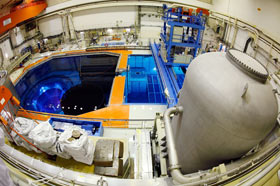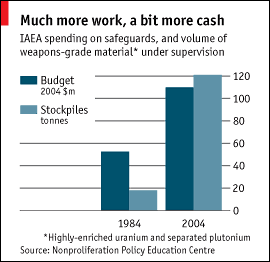| Getty Images |

A nuclear fuel pond: don't plunge
|
|
 |
|
|
A nuclear fuel pond: don't plunge |
IF THE predictions of the nuclear industry prove correct, and concerns about carbon emissions and climate change drive more governments to start investing in nuclear power to keep the lights on, how will the world protect itself from the technology's inherent dangers? It is not just the risk of accidents that keeps people awake at night. Some materials and technologies used to generate electricity can, without a lot of extra effort, be abused for bomb-making. And with more and more nuclear material being processed and reprocessed—as mostly uranium-laden reactor fuel-rods turn into mostly plutonium-laden spent fuel—the possibilities for theft or diversion can only grow. A crude nuclear device, or a dirty bomb that spews radioactive debris about, is everyone's nightmare.
The scale of the potential problem is getting clearer: 31 countries already operate large nuclear-power reactors, and some of those will be adding more. Since 2005 at least 15 more governments have said they want one too.
A whole clutch of these—Algeria, Egypt, Jordan, Libya, Morocco, Saudi Arabia, Tunisia, Turkey and Yemen—are in the fissile Middle East. Their plans seem to have been prompted in part by the discovery in 2003 of Iran's extensive, covert and hence suspicious nuclear activities. At one time or another in recent years officials from Egypt, Saudi Arabia and even Turkey, a member of NATO, have mused aloud about the possibility of a nuclear or “strategic” option. For some Muslim states, the spur to proliferate might be Israel, for others Iran. Algeria, for its part, has always been worryingly secretive about a nuclear research reactor discovered in 1991 and that it surrounds with air defences.
Not all the supposedly “civilian” nuclear plans now being laid will come to fruition. But some will. Meanwhile a detailed two-year study by the Nonproliferation Policy Education Centre (NPEC), a Washington-based think-tank, has uncovered troubling flaws in the internationally approved verification and monitoring procedures for safeguarding nuclear materials against diversion or theft.
In a new report, NPEC's director, Henry Sokolski, argues that UN nuclear inspectors from the International Atomic Energy Agency have too little money for the job they are asked to do. Not only that, but the yardsticks by which the IAEA measures its own safeguarding success are woefully out of date. Indeed, some of its supposed safeguarding, Mr Sokolski argues, is inherently undoable.
|
|
|
 |
|
|
|
The money problem is easier to remedy. As the chart shows, the amount of potentially weapons-usable nuclear material—either highly enriched uranium or separated plutonium—under inspection has increased far faster than the funds available for safeguarding it. New methods and technologies have increased the efficiency of inspections, but the IAEA's director-general, Mohamed ElBaradei, has long complained that his regular budget does not even cover all costs; it has to be topped up by less certain voluntary contributions, mostly from America. Among the few things America and Russia agree on now is that the IAEA needs more cash.
Without more money, Mr ElBaradei told his agency's 35-country board in June, safeguarding capacity will diminish. Last month he said he would ask a panel of experts to look at an internal review of safeguards-spending requirements—and then come up with some ideas about ways to meet them.
One improvement, suggests Mr Sokolski, would be to install more real-time remote-monitoring cameras, so inspectors can check more reliably that materials and equipment are not being diverted to covert use. According to the NPEC study, over the past six years the IAEA has learned of camera “blackouts” that lasted for more than 30 hours on 12 separate occasions. It found the gaps only after inspectors visited the sites and downloaded the camera recordings, as they do every 90 days.
That is more than enough time to divert nuclear material and make mischief with it. The IAEA assesses these things using a measure of militarily “significant quantity”: the amount of highly enriched uranium (25kg) or separated plutonium (8kg) it would take to make a weapon. But these quantities were arrived at 30 years ago. The NPEC study finds them too high by between 25% and 800%, depending on the type of weapon and yield required. What is more, in each case what the IAEA considers timely detection of such diverted quantities exceeds the time needed to process the materials for weapons use.
All the more important, then, to keep a close eye on plants that produce quantities of such dangerous materials—especially where uranium is enriched and plutonium is extracted from spent fuel. But NPEC's conclusion is that proper verification here is impossible. At best, the report says, the IAEA can improve its monitoring techniques (those more capable cameras would help).
That is because of the volume of material involved and the way the plants work. Material unaccounted for (called MUF) is often stuck in piping. Discrepancies, even at the best-run plants, can amount to many bombs' worth. And it can take months for inspectors to be confident they have it all more or less accounted for. Imagine the problems if the IAEA is attempting to monitor such plants in a country like Iran, with its past record of lying to inspectors.
Mr ElBaradei and others have suggested multinational fuel centres as a way to avoid dangerous technologies being abused by individual governments. But safeguarding those would be no easier. Better that such fuel-making technology isn't spread around at all.